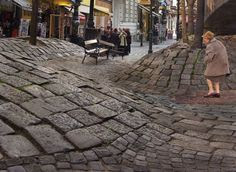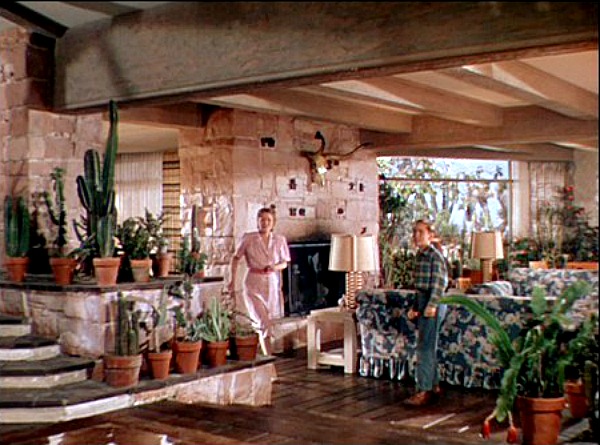For comparison: two small moons of Saturn, both embedded in the planet's rings. The one above is Pandora. It's strangely smooth. Where are all the little craters you'd expect? Maybe the surface is relatively young, but how could that be?
Here's the other one: Hyperion. Wow! Could two moons be more different?
Just to fill out the post: here's (above) the view from Jupiter's South Pole. Where are the bands?
Above, the surface of Comet 67p., seen from 16 kilometers away.
Thursday, February 23, 2017
Wednesday, February 22, 2017
WOOD AND BRICKS
What do you think of this tiny house by Sou Fujimoto? Okay, it doesn't look very comfortable, but it's only a proof-of-concept structure, not a finished house, and it certainly makes its point.
Geez, if the world is going to contain many houses like this then we better start planting trees on a massive scale.
Fujimoto loves wood and who can blame him? it's a beautiful material that's easily worked.
Enough talk about wood! Let's talk about bricks!
There's some terrific brick ideas out there, like this one (above) by Ninbo, but they're not mass market yet. You have to special order them, or make your own designs at home.
Maybe the reason the new styles haven't caught on yet is that so many are not load bearing. Not only that, but they're porous...they let in too much cold air to be practical in a house.
Too high and you lose sight of the individual stones and tiles. You get a texture that resembles a wool sweater.
Haw! All this is making me realize how beautiful and practical standard bricks are. Even a sloppy mortar job looks good on them.
BTW, What do you think of the color of these bricks?
Labels:
architecture,
bricks,
fujimoto,
ninbo,
wood
Sunday, February 19, 2017
HYBRID ARCHITECTURE
Boy, the 50s was a great time for architecture.
I suspect though, that few thoroughly modern houses were built in that period. Most were hybrids.
There was a transition period where modern design was simply incorporated into traditional houses. That's okay. It was a great combination.
Newer architects prefer to emphasize the kitchen. Fireplaces and sofas are retained but are increasingly seen as comforting symbols rather than workhorses that pull their own weight.
Foyers and entrance points also have less emphasis now. They're not seen as an art form in themselves but rather as an introduction to the puzzle presented by the odd angles in the living room and kitchen.
Living rooms are the sites of endless experiments now. Here (above) Frank Lloyd Wright toyed with idea of putting bleachers in the living room. Yeah, bleachers...like the ones in your high school gym... and they work, at least I think they do. I've never actually been in a room like that.
Even staircases are being re-evaluated. Here's (above) an interesting staircase that looks traditional and modern at the same time.
The new idea (above) is to de-emphasize stairs. Maybe that's a carry-over from the tiny house movement. It might also have come about through the influence of film. Set designers always like to stage action in front of deep perspective or glimpses into other rooms.
Well, there's lots more to say about this but I'll save that for another post. Geez, I hope all these architectural posts won't scare away all my cartoonist readers. I'm moving and will almost certainly have to remodel a bit. For someone like that thoughts about architecture are inevitable.
Friday, February 17, 2017
FISHING POSTERS
It occurred to me that maybe I should minimize what's framed on the wall and let the architecture speak for itself. Maybe I should aim for a just a handful of emotionally neutral pictures that recede into the background. Something soothing and relaxing. Some subject like.... fishing.
When I looked up fly fishing posters on the net I discovered that they're anything but relaxing. They're all pictures of stressed out manly men, men who are pitted against horrific, titanic forces.
Who'd have thunk? It's odd because the fish most Sunday fisherman catch are tiny things no bigger than your hand.
Fish grabbers see themselves as more humane because they release the fish after they catch them. I don't know, though. I don't think fish like to be manhandled.
I even found lots of abstract, Cliff Sterrett/Picasso-type fish posters. Who'd have thought that fish people would go for artsy stuff like that?
Well, eventually I found the sedate pictures I was looking for, but... I dunno...maybe I'll try something else.
Chess posters? Here's the world famous Nimzo Indian Defense (or maybe Nimzo is the name of the poster company).
Or a lucky poker hand.
Or a picture of a singing cowboy. Aaaargh! I don't know.
Labels:
fish grabbing.,
fishing,
posters,
singing cowboy
Thursday, February 16, 2017
FRANK LLOYD WRIGHT MISTAKES
Like most people I'm a huge fan of Frank Lloyd Wright, but he's not above making mistakes. Nobody is. I thought it might be fun to review some of his faux pas.
Some of the worse offenders are his plywood chairs, like the one above. This chair is missing its cushions, but even so....
For a time Wright fell in love with plywood and used it to make visible walls even in his upscale houses, something few modern architects would do.
A more serious problem is his lack of interest in bedrooms and kitchens.
Let's face it. A lot of his chairs don't look very comfortable.
For a time Wright fell in love with plywood and used it to make visible walls even in his upscale houses, something few modern architects would do.
A more serious problem is his lack of interest in bedrooms and kitchens.
Here's (above) a Wright bedroom. It's a living room with a bed in it. Taken alone it looks great but imagine a whole house where every room is a living room...it's just too much of a good thing. I see homes as a confederacy of different moods and purposes, the way nature itself is.
Here's another bedroom. It feels like a family room or a study that's doing double duty.
Here's a kitchen that also looks like a study. You get the feeling that the man never spent much time in kitchens.
Lots of people think of landscaping as an art form but the subject seemed to bore Wright. All he seemed to want around his houses (above) was a nicely mowed lawn.
His low-budget Usonian houses seemed all the more stark and unappealing on the plain lawns.
Does anything I mentioned diminish the architect's stature in my eyes? Nope. Not a jot. He's still the greatest builder of homes that I'm aware of. I only mean to point out that nobody's ever perfect, not even the greatest geniuses.
Labels:
architecture,
frank lloyd wright,
lawns,
mistakes
Monday, February 13, 2017
THE HOUSE FROM "LEAVE HER TO HEAVEN"
Architecture is on my mind these days, and I thought I'd talk about another favorite film house...this one from the 1945 thriller, "Leave Her to Heaven." The stars: Gene Tierney and Cornel Wilde. The director: John M. Stahl. The location: Arizona. Gee, I wish I knew the art director's name because this post is really about his work.
And here's an indoor shot highlighting one of the best staircases in all of film. It's only rival...in my opinion... is the Czar's staircase in Von Sternberg's "Catherine the Great."
This interior was built on a set in L.A. If I understand right
it was inspired by a real house in Arizona, but lots of alterations were made by the set designer. Not bad, eh?
Above, a slightly different angle.
This house (above) is cozy as well as modern. That's a trademark of architect Cliff May. You don't suppose he had a hand in this film, do you?
The dining area (above) is raised two or three steps above the living room. Nice.
Of course, it helps to have Gene Tierney serving up the meal.
Above, the area in front of the dining table.
Here's (above) the set of another house in the film.
How do you like the Dutch door and the large windows that go all the way down to the floor?
BTW: Most of these pictures were found on a site called "Hooked on Houses."
Labels:
architecture,
cliff may,
gene tierney,
houses,
leave her to heaven
Subscribe to:
Posts (Atom)



















































